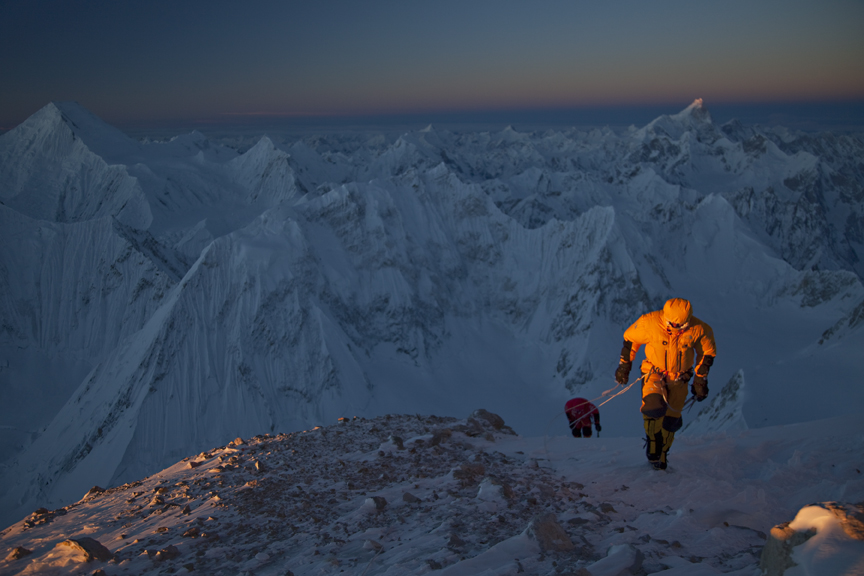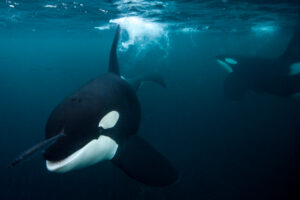Akira Oyabe’s North Japan K2 Expedition opened the Karakorum season earlier this month when they started fixing ropes for their attempt on K2. ExWeb takes a broad look at all the teams currently in the Karakorum, and what to expect this year.

K2. Photo: KhRizwani
The Savage Mountain
Although the second highest peak in the world, K2 (8,611m) sees only a fraction of the climbing traffic of Everest. Of course, “second-highest” does not bestow the same prestige to peak baggers wishing to brag about their conquest, but this is only a corner of the picture. In reality, K2 is different from Everest in every respect; in particular, its technical challenge and squirrelly weather.
The 130km trek to the starting point of K2 is double that to Everest Base Camp. But where the hike up the Khumbu is undulating, and dotted with villages, tea houses and helipads, the trail to K2 is deserted and a sharp ascent from the start. Yes, Mount Everest is taller, but K2 is much harder. It is steeper and relentless, with higher risks of rockfall and avalanche.
K2 has more unpredictable weather than Everest: Its imposing solitary stature generates a notoriously unstable microclimate, with temperatures at the summit plummeting as low as -50°C.
All of this contributes to K2’s daunting 20 percent fatality rate, far exceeding Everest’s three percent. High winds and avalanche conditions frequently lead to seasons with no summits: In the nine years from 2009 to 2017, climbers have failed to summit in five of them. Last year, Vanessa O’Brien led the only successful party.
However, more difficulty means a more coveted prize in mountaineering. Increasingly, the alpine world’s attention is turning towards K2, as Mount Everest becomes associated with commercialism and comfort.
The Karakorum
In addition to K2, the Karakorum contains another three of the 14 eight-thousanders: Gasherbrum I (8,080m), Gasherbrum II (8,035m) and Broad Peak (8,047m). Countless other 6,000 to 7,000m peaks tempt the committed alpinist. The majority of climbing in the Himalaya happens in the short May window before the monsoon brings bad weather for the entire summer. Lying far northwest of the Himalaya, the Karakorum often – though not always – escapes the monsoon, and July–August is the best time to climb.
This year, teams have permits for K2, Gasherbrum I-IV, Nanga Parbat, Broad Peak, Spantic Peak and Urdo Kangri II.

Gasherbrum II. Photo: Scarpa/Cory Richards
Teams
K2
K2 will see the most traffic in the Karakorum, with 44 climbers that we know of. Team leaders on K2 include Akira Oyabe (Japan), Dan Mazur (USA), Sergio Mingote (Spain), Serge Dessureault (Canada), Rodrigo Vial (Chile), Roland Striemitzer (Austria), Garrett Madison (USA) and Hiroshi Kawasaki (Japan). Many of these teams also have permits for Broad Peak, which is often used as an acclimatization climb. Of note, Madison’s group includes the top Hungarian climber David Klein.
If simply summiting the Savage Mountain is not enough, Polish skier Andrzej Bargiel returns this year for his second attempt at becoming the first to complete a ski descent of K2.

Garrett Madison, leader of one of the US teams. Photo: Karrar Haidri
K7
At the head of the Charakusa Valley, K7 (6,934m) was ascended first by a Japanese team in 1984 and second by Steve House, who soloed a new route 20 years later. This summer, the ace German climbers Alex Huber and Fabian Buhl, who made the first free ascent of ‘Sueños de Invierno’ in Spain in 2016, have turned their formidable talents to K7. The combination of such an iconic mountain and such strong climbers piques curiosity about their exact plans. Raphael Slawinski, one of Canada’s leading alpinists, is also heading to Dansam (6,666m) and K7 with Alik Berg. Will 2018 be the year a new route is opened on K7?
K7 West. Photo: Archives of the expedition Charakusa 2011
Testament to its technical difficulty, Nanga Parbat (8,126m) was first climbed in winter only in 2016, by Simone Moro, Ali Sadpara and Alex Txikon. This January, Nanga Parbat, or “Naked Mountain” in Urdu, shot into the news when Pole Tomasz Mackiewicz and Frenchwoman Elisabeth Revol bagged the second winter ascent but suffered snow blindness and altitude sickness during the way down. A rescue team of Polish climbers — flown in by the Pakistani army from their own attempt to make the first winter climb of K2 — managed to save Revol, but Mackiewicz perished.
Since early this month, South African adventurer Mike Horn has been on the Diamir Face, making slow progress because of bad weather. Horn’s high-altitude CV already includes six of the 14 eight-thousanders.
Also on Nanga Parbat, the adventure company Lela has organized a strong team of six, led by Peruvian Richard Leopoldo Hidalgo Jara and including veteran Turk Tunc Findik and Alex Gavan, the Romanian mountaineer who specializes in climbing without O2.
Pavel Korinek returns to Nanga Parbat to lead an all-Czech team of nine to climb the Diamir Face.

Climbing Mummery Rib, Nanga Parbat. Photo: Daniele Nardi
G-IV
Sometimes called the “beautiful mountain”, Gasherbrum IV (7925m) has no easy routes. The legendary West Face, the “Shining Wall”, is recognized as one of the most beautiful and challenging in the world. Despite expeditions throughout the 80s, 90s, and more sporadically this millennium, there remain no established routes on the South or East Faces. At least four teams are on G-IV this summer. Maria Valdimirovna is leading another Lela expedition, which also has permits for G-I and G-II. Valerio Stella heads an all-Italian team of four. Finally, a three-man team of German Climber Felix Berg and Poles Adam Bielecki and Jacek Czech will first acclimatize on G-II, then head to G-IV to open a route on the eastern wall. So Karakorum 2018 may see more than one pioneering route laid down.

G-IV on a “clear-sky-storm-day”. Photo: SummitPost
Latok I
First climbed by the Japanese in 1979, Latok I (7,145m) is notable for its extreme technical difficulty. This year, it has already seen turmoil, as a team of South Korean climbers required rescue from the North Face. There are also two three-man Russian teams on Latok I, led by Konstantin Markevich and 2015 Piolet D’Or winner Aleksandr Gukov. Last but not least, Ales Cesen leads a three-man Slovenian team. Cesen climbed the Northwest Ridge of Gasherbrum IV to reach the North Summit in 2016.

Latok I, North Ridge. Photo: American Alpine Club
Links
Exclusive Pt. 1: K2 2017 Interview with Vanessa O’Brien
Exclusive Pt. 2: K2 2017 Interview with Vanessa O’Brien
Exclusive Pt. 3: K2 2017 Interview with Vanessa O’Brien
Nanga Parbat happy and unhappy end
Elisabeth Revol Describes Nanga Parbat Rescue
The end of the rescue operation at Nanga Parbat






